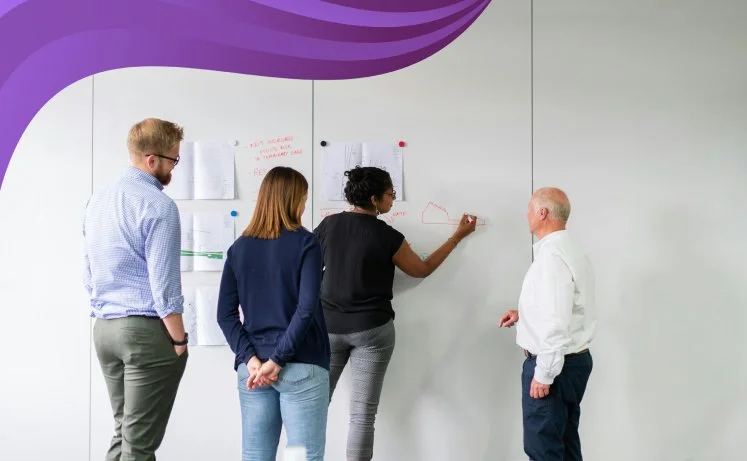
6. Change Resiliency Series
Resiliency Intelligence
6.1 Understanding Resiliency Intelligence
We all have moments when stress, change, or conflict push our buttons—and how we respond in those moments can strengthen or weaken our resilience. This workshop helps you identify the forces that support your ability to cope, the internal “dark forces” that trigger unhelpful reactions, and the emotional patterns you default to under threat. By understanding these patterns, you’ll be better equipped to pause, choose your response, and protect your energy in challenging situations.
-
Recognizing my emotional patterns so I can choose my response instead of reacting on autopilot.
-
Foundations of Resiliency Intelligence
Identifying “dark forces” (saboteurs) that impact emotional regulation including self-talk, cognitive distortions, and limiting beliefs
Fight–flight–freeze–fawn responses and their impact
-
Be prepared for your emotional “triggers” and recognize internal thought patterns that lead to unhelpful emotional states
Anticipate default responses to stress so you can pause and choose a better approach
Identify personal strengths and supports that boost resilience
-
What forces are at work that contribute to my resiliency and ability to manage emotions?
What “dark forces” in my mind trigger me and contribute to my negative emotions?
What are my default emotional responses to threats?
6.2 Build your Resiliency Muscles
6.3 Overcoming Brain Barriers to Change (Managing Resistance)
In Understanding Resiliency Intelligence, you identified the triggers and emotional patterns that can derail your composure. In this module, you’ll shift from awareness to action—learning and practicing strategies to quiet the “dark forces” in your mind, stay grounded under pressure, and strengthen the mental and emotional habits that support resilience in the face of conflict, change, and stress.
-
Stay grounded and clear-headed, even when the pressure is on.
-
The link between resilience, conflict, and change leadership
Techniques for calming the mind and body (e.g., breathwork, grounding exercises, reframing thoughts)
Mindset shifts to quiet negative self-talk and reduce reactivity
Daily habits and micro-practices to strengthen resiliency “muscles”
-
Use calming and grounding techniques to stay present in tense moments
Manage emotional energy to avoid burnout and decision fatigue
Build capacity for constructive conflict, adaptive change, and stress recovery
Develop routines and habits that strengthen resilience over time
-
How does resiliency pave the way for productive conflict, change, and stress management?
What can I do to calm the dark forces at play in my mind?
What can I do to build my resiliency muscles and improve my response to threats?
Resistance to change isn’t laziness or defiance—it’s biology. Our brains are wired to cling to the familiar and react to change as a threat. This module helps leaders understand the neurological and emotional patterns that drive resistance and equips them with practical tools to shift people from a survival mindset to one of growth and possibility. By reframing change and making transitions easier, leaders can reduce fear, unlock motivation, and create momentum.
-
Frame change in ways that reduce threat and help people move from resistance to readiness.
-
The neuroscience of resistance: survival brain vs. thriving brain (John Kotter)
William Bridges’ Transition Model: endings, neutral zone, and new beginnings
“Direct the Rider, Motivate the Elephant, Shape the Path” framework (Jonathan Haidt; Chip & Dan Heath, Switch)
Practical strategies for recognizing resistance patterns (SCARF model, Neuroleadership Institute) and making transitions easier
-
Spot early signs of resistance and address them with empathy and clarity
Apply simple practices to help people move through transitions with less friction
-
Why does the brain resist change, and what happens to people neurologically and emotionally during transitions?
What common brain barriers show up during change, and how can I recognize them early?
How can I make change feel less threatening—shifting from the survival brain to the thriving brain—and practice ways to make transitions easier?
6.4 Making Change Stick
Change doesn’t fail because people don’t care—it fails because leaders underestimate the barriers that teams face in practice. In this lab, participants bring their own change projects and work through common team obstacles and leave with an action plan to build commitment and reinforce change momentum.
-
Guide change efforts with foresight—anticipating barriers and designing strategies to overcome them.
-
Common team and organizational barriers to change (ADKAR model, Prosci)
Practical tools for awareness, desire/motivation, and capability/knowledge-building
Anticipating resistance and designing proactive responses
Reinforcement strategies to keep change alive over time
Case application: participants analyze and apply tools to their own projects
-
Diagnose barriers in current change initiatives and develop mitigation strategies
Build targeted communication and engagement plans for real projects
Apply techniques to strengthen motivation and capability on the ground
Design reinforcement practices to sustain momentum after implementation
-
What team and organizational barriers undermine change efforts?
What strategies can I apply to build awareness, spark motivation, and grow capability in my team during change?
How can I anticipate and address resistance before it derails progress?
What can I do as a leader to reinforce progress and help make change last?
6.5 Understanding the Change Landscape
You can’t lead change effectively if you don’t understand the terrain. Every organization operates within a web of internal and external forces—political, economic, social, technological, cultural, and regulatory—that shape how change unfolds. By scanning the landscape, leaders learn to anticipate risks, spot opportunities, and position initiatives for success.
-
Scan the horizon to anticipate change and adapt proactively.
-
Environmental scanning frameworks (PESTLE, SWOT applied to change)
Identifying internal drivers (culture, leadership, structure) vs. external drivers (regulatory, market, societal shifts)
Lessons learned from past change successes and failures
Applying the “change landscape” lens to current or upcoming initiatives
-
Conduct environmental scans to understand pressures shaping your organization
Anticipate risks and opportunities before launching change initiatives
Learn from past organizational change efforts to avoid repeating mistakes
Position projects and strategies to align with broader organizational drivers
-
What internal and external forces are shaping my organization’s change environment?
How do these forces create both risks and opportunities for change?
What patterns of past change successes or failures can I learn from to navigate today’s challenges?
How can I apply this broader view of the change landscape to position my initiatives for success?
6.6 Assessing Change Readiness
Even the best strategy will fail if the organization isn’t ready to change. This module helps leaders assess where individuals, teams, and the broader system are most prepared—or most resistant—and adapt their approach accordingly. By diagnosing readiness, leaders can focus energy where it’s needed most and build momentum for transformation.
-
Assess readiness before acting—adapting change strategies to meet people where they are.
-
The concept of change readiness and why it matters
Tools and techniques for assessing readiness (surveys, stakeholder mapping, interviews, observation)
Using readiness insights to adapt strategy and communication
Case examples of tailoring approaches based on readiness levels
-
Diagnose readiness at the team and organizational levels
Adjust plans and supports to build momentum and reduce barriers
-
What does “change readiness” mean, and why does it matter for successful transformation?
How do I assess where teams and the organization are most ready—or most resistant—to change?
How do I tailor my change approach based on different levels of readiness?
6.7 Accelerating Change
Too many change initiatives stall because they move at the pace of hierarchy, not the pace of urgency. Drawing from John Kotter’s Accelerate, this module equips leaders to drive change faster by cutting through change obstacles and engaging people across the system.
-
Mobilize networks to accelerate change.
-
Why change stalls: hierarchy vs. network (dual operating system)
Kotter’s 8 Accelerators (Accelerate model)
-
Diagnose why a change initiative is slowing down and re-energize it
Apply Kotter’s accelerators to build a guiding coalition and network of champions
Design communication strategies that amplify urgency or opportunity and spark action
-
Why do change efforts stall, and what can leaders do to accelerate them?
How can I use accelerators to mobilize energy and commitment?
6.8 Sustaining Change Momentum
Launching change is hard, but keeping it alive is even harder. This module equips leaders to sustain momentum by shifting from a project-management mindset to a leadership approach grounded in opportunity-seeking and continuous adaptation.
-
Keep change in motion by reframing it as continuous opportunity and actively addressing system-level barriers.
-
Kotter’s shift from urgency to opportunity (Change)
Leadership-centric vs. management-centric approaches to sustaining change
Barry Oshry’s system dynamics: “burdened tops” and “torn middles”
Practical reinforcement strategies to sustain energy and embed change in culture
-
Spot and address system blind spots that stall or drain energy from change
Apply leadership-centric strategies to sustain engagement and alignment
Reinforce progress with practices that lock change into culture and prevent backsliding
-
How can leaders sustain change momentum by shifting from managing projects to leading with an opportunity-seeking mindset?
How do system blind spots drain change momentum, and what can leaders do to overcome them?
What leadership-centric approaches to strategy help keep change moving forward as a continuous process that’s embedded in culture, not a one-time initiative?







